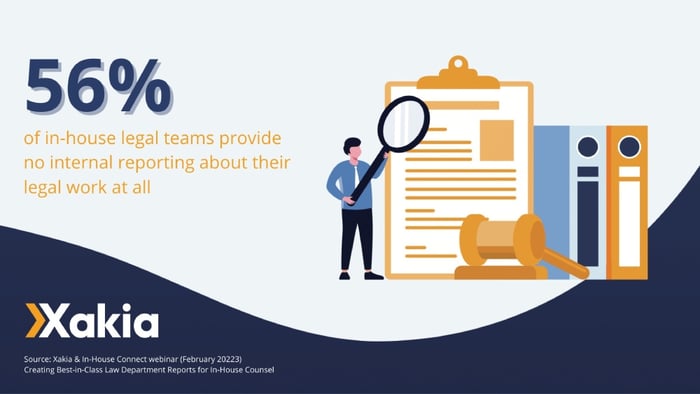In this blog about legal reporting for difference audiences, we look at your business unit clients.
A 2017 roundup of the most common mistakes in-house lawyers make is chilling reading, to be sure – but it’s also a striking reminder that proactive communication can prevent many pitfalls. Indeed, of the 14 errors outlined by Barker Gilmore, six speak directly to the need for information flow between the Legal Department and the business units.

Smart, regular legal reporting to key stakeholders can help your legal team avoid the following mistakes:
1. Explaining things to business people in heavy legalese
When legal reporting evolves from text-heavy memos to action-oriented dashboards, the corporate Legal Department starts to speak the language of business. (Consider how Marketing, IT and Finance report – they use charts and graphs, not lawyerly paragraphs.) As the General Counsel at BlueScope said: "Business people think in charts and graphs; lawyers think in blocks of text."
2. Offering advice that doesn’t correspond to the business strategy
Smart in-house Legal Departments will track and report their legal matters by strategic value. This mandates an alignment of legal work with corporate objectives, and allows the Legal Department to quickly demonstrate how it is working to advance the goals of the business – not just functioning as the “Department of No.”
3. Failing to integrate with other departments
The preparation and delivery of regular reports from your legal matter software prompts routine discussion with business unit heads. This shows each business unit what exactly the corporate Legal Department is doing for them – whether that’s clearing new trademarks, negotiating contracts or monitoring new regulation – and provides an opportunity for proactive discussion of what’s next.
4. Taking on too much work for business units
Without information and context, business unit heads operate in a vacuum. They will not necessarily understand why all of their legal requests are not top priority (or even possible). A smart legal report can show the amount of legal matters you are handling for them and the resources consumed – while also showing how the business unit fits in the big picture of legal risk, strategy and budget. This can empower your legal team to say no…and it might inspire both sides to look for ways to eliminate, automate or streamline routine work.

5. Failing to understand your company’s accepted risk tolerance
Just as risk comes in many varieties – legal, regulatory, financial, et cetera – so do the risk profiles and challenges of your business units. No business unit wants to embarrass the organization. Show IT your work supporting data security, show HR how employee claims are trending.
6. Failing to gain clients’ trust
According to loyalty expert James Kane, there are four elements of trust in business relationships:
- Competence (knowledge to do the work)
- Character (behaving ethically)
- Consistency (delivering reliably)
- Capacity (resources to do the work)
Regular legal reports for business units – such as those prepared quarterly – establish consistency and reinforce your legal team's competence, character and capacity.
What should you include in your legal reports to your business unit clients?
As every organization chart is different, so is every business. Your roster of business units will vary depending on your specific context. Your business unit reports could cover specific functions, departments, geographic territories and so forth – but no matter how you’re organized, some general best practices apply. A legal matter management software can help generate these legal reports for your business unit clients.
Matters list
Your business unit heads don’t necessarily need a full inventory of every single matter. You could start with a list of the key matters that affect their business units – filtered for priority or risk profile – and provide straightforward status updates.
Budget
If your business units are responsible for any share of the legal fees, they should understand how their legal budgets are trending – and what exactly they are responsible for funding.
Resourcing
How is the business unit consuming hours and dollars from in-house staff, external law firms and legal vendors? How is this trending over time, and is it proportionate to the unit’s size, revenue contribution, et cetera?
Work types
Provide metrics by work categories, such as contract negotiation, employment issue, litigation, intellectual property, et cetera. Seeing how the business unit’s legal work trends across various work types can help managers troubleshoot – for example, identifying a problematic employment policy, a litigation-prone product, et cetera.
Next, help the business unit managers understand their legal work in context: How does their profile compare with the business as a whole? What is the narrative? How has this changed over time? This can span several key areas.
Demand
Is there a trend of growing or declining work? Are there trends that need to be addressed with training or additional resources?
Risk
Whether it’s legal risk, financial risk, business risk or reputational risk, your business unit managers should understand their specific stakes. For ease of tracking and reporting, we recommend specific settings, such as low, medium, high and critical. Assuming you have assigned a risk level for every matter, you can efficiently chart every business unit’s risk profile – then show them how they compare to the business as a whole.
Strategic value
Sometimes business unit managers struggle to understand why their work is not always a top priority. By showing them the big picture – and how their work fits into it – you can better manage expectations, both now and in the future. And by drilling down into their low-strategic-value work, you may find opportunities to eliminate or automate legal work, making life easier for both of you.
How often should you deliver these legal reports to your business unit clients?
Resist the urge to attach your report to an email and hit send. Remember that one primary reason for preparing this report is to strengthen your relationships with the business units. Whenever possible, deliver your report in person at a quarterly meeting - it's easy with a legal analytics software solution.
What do these legal reports look like?
Download our white paper, Best-in-Class Legal Reporting today to learn more. You will receive tips for content, cadence and delivery, as well as sample reports and practical guidance for collecting and illustrating your data.
And with a legal analytics software such as Xakia, these reports can be automated – allowing you to build your relationships without burning time on manual reports. To learn more, book a demo with Xakia today.
